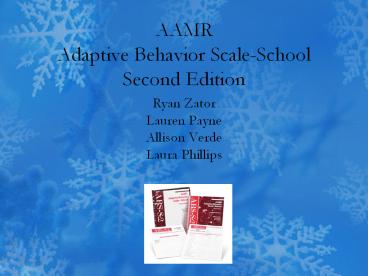AAMR Adaptive Behavior Scale-School Second Edition - PowerPoint PPT Presentation
1 / 20
Title:
AAMR Adaptive Behavior Scale-School Second Edition
Description:
Title: AAMR Adaptive Behavior Scale-School Second Edition Created Date: 11/14/2006 11:31:46 PM Document presentation format: On-screen Show Company – PowerPoint PPT presentation
Number of Views:503
Avg rating:3.0/5.0
Title: AAMR Adaptive Behavior Scale-School Second Edition
1
AAMRAdaptive Behavior Scale-SchoolSecond Edition
- Ryan Zator
- Lauren Payne
- Allison Verde
- Laura Phillips
2
Instrument Introduction
- Author- Nadine Lambert, Kazuo Nihira Henry
Leland - Publisher- Pro-ed
- Cost- 165.00
3
Description
- Purpose of Assessment
- Determine strengths and weaknesses among adaptive
domains and factors - Identifies students who are significantly below
their peers in important areas of adaptive
behavior - Document the progress of individuals who are
enrolled in intervention programs - Measure adaptive behavior in research studies
- Can be used in the differential diagnosis of
Mental Retardation
4
Target Population
- Individuals ages three to twenty-one whose
adaptive behavior suggests possible mental
retardation, emotional disturbance, or other
learning handicaps.
5
Subtests
- Part 1
- Nine Domains
- Independent functioning
- Physical Development
- Economic Activity
- Language Development
- Numbers Time
- Prevocational/Vocational Activity
- Self-Direction
- Responsibility
- Socialization
6
Subtests Continued
- Part 2
- Seven Domains
- Social Behavior
- Conformity
- Trustworthiness
- Stereotyped Hyperactive Behavior
- Self-Abusive Behavior
- Social Engagement
- Disturbing Interpersonal Behavior
7
Administration
- Time
- Manual suggest 1-2 hours
- Qualifications
- May be administered by any trained person who has
either direct knowledge of the person being
evaluated or is able to gain information from a
third party. - Training
- Person should have formal training in assessment
and adaptive behavior instruments.
8
Administration Continued
- Individual administration
- Ratings obtained in two ways
- Personal knowledge of the individual being rated
- Another persons knowledge obtained from the
interview
9
Scoring
- Part 1
- Some items require a yes/no response and others
require selecting the appropriate level on a
scale of 0-3. - Part 2
- Scoring is based on frequency
- Five Scoring Types
- Raw Scores
- Percentiles
- Domain Standard Scores
- Factor Standard Scores
- Age Equivalence
10
Use of Results
- Planning Adjusting I.E.Ps
- Determining L.R.E
11
Development
- The ABS-S2 is the 1993 revision of the 1975 and
1981 AAMD Adaptive Behavior Scales. - Numerous Modifications
- Based on Authors suggestions and critical
analysis, there is a third edition in the future
12
Technical
- Reliability
- Internal Consistency was only tested for the
original version in 1975 - Test-Retest Reliability (Perry Factor 1989)
- Included 15 children and adolescents with
Autism. - Part One .53(prevocational activity) to .98
(numbers time) - Part Two .50 (vocal habits) to .90 (symptomatic
behavior)
13
Technical Continued
- Test-Retest Reliability
- Cheramine Edwards (1990)
- 66 Elementary school children ranging in age from
7-13y/o and classified as having behavior
disorders, referred for problems but not
classified, and children who were not referred. - Ranged from .63 (acceptability of vocal habits)-
.99 (withdrawal vs. involvement)
14
Technical Continued
- Test-Retest Reliability
- Givens Givens Ward (1982)
- 49 regular class children using sub domain and
domain scores for both part one and part two. - Part One .43 ( vocational activity) - .89 (
language development and self direction) - Part Two Values were lower, possibly resulting
in the expected restricted range of these ratings
for regular class children.
15
Technical Continued
- Validity
- Part One
- Construct Validity- Correlation with age 0-18.
(.41) - Criterion Validity- Correlation with IQ. There
is a range depending on whether or not the
student had disabilities or not. (.41-.72) - Part Two
- There was no validity
16
Technical Continued
- Standardization
- Scale was normed over 2,000 persons with MR and
over 1,000 persons without MR across the U.S - Results of studies of children differing with
respect to socio-economic level and ethnic status
showed that the items of the scale were not
affected by social or ethnic status bias.
(supported by Lambert 1979 Boyd and Chissom
1979)
17
References
- Benet, W. PhD, Psy.D. Retrieved November 12,
2006, www.assessmentpsychology.com/adativebehavior
.htm. - Lambert, N. , Leland, H. , Nihira, K. (1993)
AAMR Adaptive Behavior Scale-School Second
Edition.
18
Commentary
- Strengths
- Specific criteria guides test administrator(s)
- The norm sample consisted of individuals with
disabilities and individuals without
disabilities.
19
Commentary Continued
- Weaknesses
- Not all items are clear
- The items aren't scaled according to severity
- Some items are questionably grouped under a
domain - Not all categories are applicable to all students
- Some information obtained from a third party, can
be biased - Certain domains allow for subjective answers
- No matter what, students cannot be observed at
all times
20
Summary
- Lack of experience
- Found more weaknesses than strengths
- Conversion of Scores
- Recommendation
- Vineland Adaptive Behavior Scales
- Completely Comprehensive Adaptive Behavior Scale































